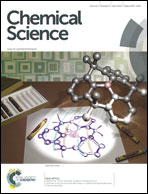Tristable [n]rotaxanes: from molecular shuttle to molecular cable car†
Abstract
New tristable [n]rotaxanes (n = 2, 3, 4) were developed based on host–guest interactions, featuring pyromellitic diimide (PmI), anthraquinone (AQ) and N-methyltriazolium (MtA) units as the three kinds of recognition sites and triptycene-derived macrocycle(s) as the moveable part. In the [2]rotaxane molecular shuttle, the states of the macrocycle on different sites can be reversibly and controllably switched using chemical stimuli. The controllable motion mode of the [2]rotaxane molecular shuttle can be extended to its analogous oligorotaxanes, thus creating synchronous behavior for the macrocycles and producing an original visual prototype of artificial molecular machines (AMMs)—molecular cable car.
![Graphical abstract: Tristable [n]rotaxanes: from molecular shuttle to molecular cable car](/en/Image/Get?imageInfo.ImageType=GA&imageInfo.ImageIdentifier.ManuscriptID=C3SC53295J&imageInfo.ImageIdentifier.Year=2014)

 Please wait while we load your content...
Please wait while we load your content...